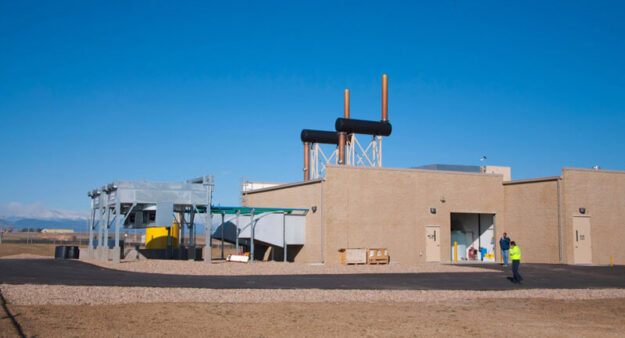Widgetized Section
Go to Admin » Appearance » Widgets » and move Gabfire Widget: Social into that MastheadOverlay zone
Colorado lawmakers look to ramp up renewable natural gas industry across state

State Sen. Kerry Donovan of Vail knows a thing or two about animal poop and human waste since they’re both big components of the family businesses — a working ranch near Edwards that she runs and the Vail Honeywagon trash collection service. She also knows you can pull renewable natural gas (RNG) — and therefore clean power — from both forms of waste.
She voted for a bill last legislative session that would have mandated large utilities get a certain percentage of their energy from RNG. It was called the Adopt Renewable Natural Gas Standard (SB20-150), and it passed the Senate 24-10 with one senator excused before being derailed in the House when the session ended abruptly due to COVID-19.
But it will be back, according to its primary Democratic sponsor, Sen. Chris Hansen of Denver, and this time he’s hoping it makes it through the Democrat-controlled House as well. Still, this is a bipartisan bill aimed at methane capture that just makes sense for the Front Range and the Western Slope, he said, noting his Republican co-sponsor is Don Coram of Montrose.
Like Donovan, Coram lists his occupation as rancher (in addition to mining), and the RNG standard bill is aimed at capturing methane not only from agricultural and landfill operations, but also wastewater treatment plants, coal mines and natural coal beds. It’s also designed to use excess renewable energy to generate hydrogen as a fuel source.
If passed, it would compel Xcel Energy – the state’s largest utility – and at some point Black Hills Energy (once it’s large enough to qualify) — to use 5% renewable natural gas by 2025, 10% by 2030 and 15% by 2035. RNG is produced by capturing methane (CH4) from both natural and manmade sources rather than releasing it into the atmosphere or even flaring it.
Methane is pound for pound 25% more potent as a heat-trapping greenhouse gas than carbon dioxide (CO2), although it’s less prevalent and doesn’t stay in the atmosphere as long, according to the U.S. Environmental Protection Agency.
Donovan says that as the price of wind and solar continues to come down, those sources of electricity will be a big focus in Colorado, which has gone from generating 76% of its electricity from coal 20 years ago to 44% coal in 2019. But she adds the state will have to get more creative to achieve its 100% renewable electricity by 2040 goal.

“We’re going to have to continue to look at low-hanging fruit, but then we’re going to have to get more and more creative and innovative with new ideas at the state level to achieve our climate-reduction goals, and those may include methane capture from landfills or partnerships with the agricultural community for them to use their land assets to sequester carbon,” Donovan said. “All of that stuff has to be on the table.”
Colorado has gone from generating a negligible amount of electricity from renewable sources 20 years ago to being a nearly 20% wind-power and 25% overall renewable state in 2019. But its reliance on drilled natural gas for electricity has increased in the span, from 20% in 2000 to 30% in 2019 – meaning it still gets 74% of its electricity from fossil fuels.
The natural gas industry – once a dominant force on the state’s Western Slope – has pulled market share away from coal, with more and more power plants being converted to gas. But it is a significant source of methane leakage. Capturing and utilizing methane for either electricity or as a transport fuel mitigates the impact of the gas on a steadily warming climate, experts say.
“With all these kind of capture ideas, you just really have to make sure that you’re working in partnership with the industry that you want to capture [methane] from,” Donovan said. “You need to go to the ag people and say, ‘Do you want to participate in this; how can we make it work? Not, hey ag, you will participate in this.’”
California’s Low Carbon Fuel Standard (LCFS), a rule aimed at reducing carbon intensity in the transportation sector that has been adopted in other states, promotes RNG development with active purchasing of LCFS credits. Again, Donovan is intrigued but want to make sure the ag community is a big part of the conversation.
“For the ag community, if you really created a carbon market, which is something I’m looking at, I think you would see adoption by the ag community because they’re really good businessmen and women who are operating at really small margins and at the whim of a commodities market,” Donovan said. “It’s really hard to be a rancher or a farmer, and so if you created another business opportunity, you would see adoption …”
Hansen took a different approach with his bill last session, which he intends to reintroduce in the 2021 session that starts on Jan. 13.
“The Low Carbon Fuel Standard to my mind is a good policy, but it’s not a great one, because it’s not very efficient when it comes to abatement [of methane] per dollar,” Hansen said. “What I’m trying to do in Colorado is a reboot of a bill that … is really focused on trying to get rid of as much greenhouse gas emissions as we can for as low a cost as we can.”

Hansen compares his RNG bill to Colorado’s first-in-the-nation, voter-approved Renewable Portfolio Standard (RPS) in 2004.
“We create a target for renewable gas, or zero-emission gas, and basically have people bring projects forward,” said Hansen, who grew up in a farm town on the Colorado-Kansas border and earned an undergraduate degree in engineering, a Master of Science from MIT and a PhD from Oxford. “Those projects would be reviewed by the PUC [Public Utilities Commission], and the best projects would get selected and invested in to meet the targets – similar to what we did with the RPS, where we went from 10 to 20 to 30 and now 80 % [renewable energy].”
The RNG projects, he says, will target the sectors that make the most sense geographically, from the landfills in the Denver metro area to the coalbed (natural) and coal-mine (manmade) methane of southern and western Colorado to ag operations all across Colorado.
“We’ve got a bill that I think will really help created opportunities for jobs and investment in Colorado,” Hansen said. “The dairies, especially in Weld County, there’s great opportunities there. The West Slope, we need to do everything we can to support the economies and jobs on the West Slope, and with the coalmine methane that’s available, there could be huge investments and new jobs created. I’m really excited about this.”
Jay Hopper, the Colorado-based vice president of business development for Michigan-based Aria Energy, which has developed RNG projects at two Denver landfills in Erie, Colo., says California’s LCFS is driving RNG production and has seen copycat programs in Oregon, Seattle, British Columbia and soon New York. But in Colorado, he says Xcel Energy is the key.
“There is no LCFS program in Colorado, so all of the natural gas that we do produce, we ship to California,” said Hopper, whose company partners with British Petroleum in its Mavericks RNG program. “We’re shipping renewable natural gas from New York to California. Colorado, not having a Low Carbon Fuel Standard, is not getting any of that gas, even though the majority of it is going through a Colorado interstate to get to California.”
The Los Angeles Metropolitan Transportation Authority, for example – the world’s second largest bus fleet behind only the nation of Sweden – displaced their conventional natural gas use with RNG. Proponents say legislation will be key to creating RNG markets in Colorado.
Hansen’s bill has the backing of the national Coalition for Renewable Natural Gas (RNG Coalition), which is in the midst of a major push called its Sustainable Methane Abatement and Recycling Timeline [SMART] initiative to capture and control the methane that’s currently produced from an estimated 43,000 organic waste sites in North America by 2050.
RNG Coalition Chief Executive Officer & Executive Director Johannes Escudero says that lofty goal is achievable because of the growth in the sector in recent years. The first RNG project in the United States, Fresh Kills Landfill in New York City, came online in 1982. Between then and when Escudero cofounded the RNG Coalition in 2011, roughly one a year was added for a total of 31 projects. By 2015, the coalition helped quadruple that rate to a total of 47.
The coalition then set a goal of 100 projects by 2025, and in fact reached that goal five and half years ahead of schedule in 2019.
“So in the last 12 months we have brought more projects online than the industry did during that first 30-year period of existence between 1982 and 2011, to give you a sense of the kind of trajectory that we’re seeing,” Escudero said, adding he wants RNG to become front of mind when people think of renewable energy – right up there with wind, solar and hydroelectric.
“We want RNG to be in that top three, because we can’t all produce wind and solar. We can’t control the wind and the sun, but we all produce waste, every one of us,” Escudero said. “And so why not support incentives that enable existing solutions to capture and control the methane from the waste that all of us are producing?”
David O. Williams
Latest posts by David O. Williams (see all)
- Immigrant rights groups push Colorado AG Weiser for probes into violations of ICE collaboration law - July 11, 2025
- First ever Habitat for Humanity homes craned into Vail as ski town tries to tackle acute housing crisis - July 9, 2025
- ‘Now we have to look at that’, Colorado AG Weiser says of challenging Trump’s energy emergency - July 8, 2025


